
Macaronesia is a collection of four volcanic archipelagos in the North Atlantic, off the coasts of Africa and Europe. Each archipelago is made up of a number of Atlantic oceanic islands, which are formed by seamounts on the ocean floor whose peaks have risen above the ocean's surface. The Azores and Madeira archipelagos are part of Portugal, the Canary Islands are part of Spain, and the rest are part of the island country of Cape Verde. Politically, the islands belonging to Portugal and Spain are part of the European Union. Geologically, Macaronesia is part of the African tectonic plate. Some of its islands – the Azores – are situated along the edge of that plate at the point where it abuts the Eurasian and North American plates.

Malva is a genus of herbaceous annual, biennial, and perennial plants in the family Malvaceae. It is one of several closely related genera in the family to bear the common English name mallow. The genus is widespread throughout the temperate, subtropical and tropical regions of Africa, Asia and Europe.
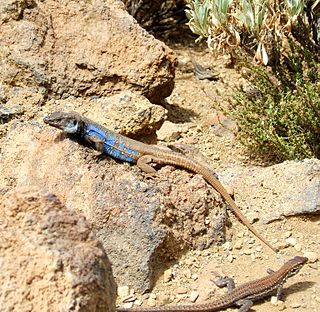
Gallotia galloti, also known commonly as Gallot's lizard, the Tenerife lizard, and the Western Canaries lizard, is a species of wall lizard in the genus Gallotia. The species is native to the Canary Islands of Tenerife and La Palma. Unlike most larger species of its genus, G. galloti is a commonly found animal. There are four recognized subspecies.

Canarina is a genus of flowering plants within the family Campanulaceae. They are herbaceous perennial vines with bell-shaped flowers. The best known species is Canarina canariensis from the laurel forests of the Canary Islands which is grown as an ornamental plant. C. canariensis is one of a group of unrelated Canarian plants that appear to be adapted for bird pollination, including the members of the genera Isoplexis and Lotus. It was once thought that the original pollinators of these plants were sunbirds which had become extinct on the Canary Islands, explaining why some of these species are rare and considered endangered. However more recent work has shown that these plants are adequately pollinated by non-specialist flower visiting birds, particularly the Canary Islands chiffchaff and the Canary Island spectacled warbler, and in fact show some specific adaptations to infrequent pollination by these birds, such as extended flower lifespans, and a hexose-dominated sugar ratio of the nectar.
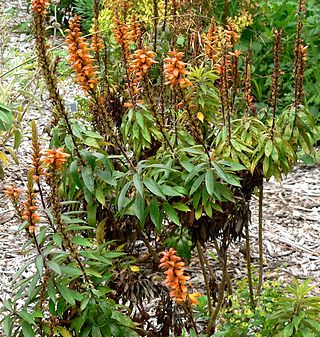
Isoplexis is a section of four species of flowering plants within the genus Digitalis in the plantain family Plantaginaceae. The species of section Isoplexis differ from other plants in the genus Digitalis in that their monosymmetric flowers have a distinctive large upper lip rather than large lower lip and the species are endemic to the Canary Islands and Madeira.
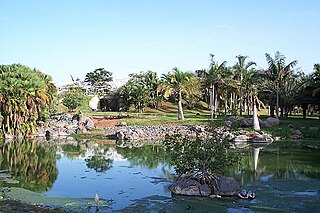
The Palmetum of Santa Cruz de Tenerife is a botanical garden of 120.000 m² specialized in palms (Arecaceae). It is an artificial hill, with views of the ocean, located in Santa Cruz de Tenerife, Canary Islands, Spain. The gardens include a large system of waterfalls, streams and ponds, a museum dedicated to palms, and a display shade house. The project was started in 1995 on a former landfill and only opened to the public in 2014. The valuable palm collection gathers about 600 species of palms and it is focused on the ones native to world islands. Trees and shrubs of other plant families are also displayed, organised in "biogeographical sections". All gardens are maintained with no pesticides and no fertilizers, different species of wild birds are easily seen in the palmetum.
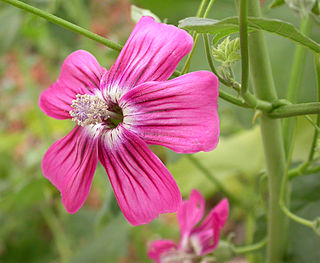
Malva assurgentiflora, formerly classified as Lavatera assurgentiflora, the island mallow, mission mallow, royal mallow, malva rosa island mallow, island tree mallow or malva rosa in Spanish, is a species of flowering plant in the mallow family.
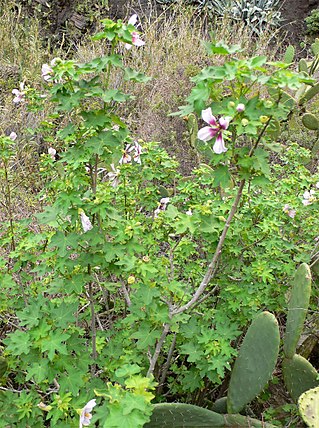
Malva acerifolia, also frequently known under the synonyms Lavatera acerifolia or Malva canariensis is a shrub endemic to the Canary Islands, belonging to the family Malvaceae.
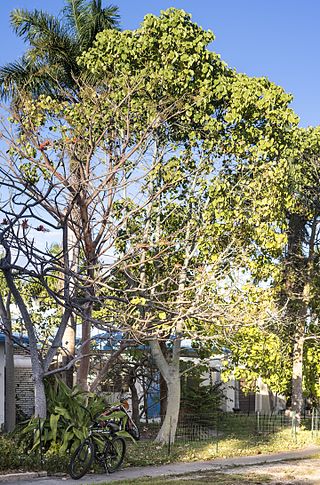
Hildegardia populifolia is a species of flowering plant in the family Malvaceae. It is found only in the Eastern Ghats of Andhra Pradesh and Tamil Nadu in India. It is threatened by habitat loss; just about 20 trees are known to exist on the eastern slopes of the Kalrayan Hills.

Malva arborea, the tree mallow, is a species of mallow native to the coasts of western Europe and the Mediterranean region, from Ireland and Britain south to Algeria and Libya, and east to Greece.

Malva sylvestris is a species of the mallow genus Malva in the family of Malvaceae and is considered to be the type species for the genus. Known as common mallow to English-speaking Europeans, it acquired the common names of cheeses, high mallow and tall mallow as it migrated from its native home in Western Europe, North Africa and Asia through the English-speaking world.

Dombeyoideae is a widely distributed subfamily of the Malvaceae, as proposed by the APG. Most of the plants placed here were once assembled with more or less related genera in the paraphyletic Sterculiaceae; a lesser number were placed in the Tiliaceae which were also not monophyletic.

Echium pininana, commonly known as the tree echium, pine echium, giant viper's-bugloss, or tower of jewels, is a species of flowering plant in the borage family Boraginaceae. It is endemic to the Canary Islands, where it is restricted to the island of La Palma. Echium pininana is an endangered species, and is listed in Appendix I to, and is therefore protected under, the Convention on the Conservation of European Wildlife and Natural Habitats. The specific epithet pininana is Latin for "small pine", though E. pininana is neither closely related to the pine, nor does it resemble that plant.

The barred hogfish is a species of wrasse native to the eastern Atlantic Ocean, where it occurs around the Macaronesian island groups of the Azores, Madeira, the Canary Islands and Cape Verde. This species occurs on rocky reefs at depths of 20 to 200 m. It can reach a length of 43 cm (17 in), though most do not exceed 30 cm (12 in). It is of minor importance to local commercial fisheries. This species was formally described as Labrus scrofa in 1839 by Achille Valenciennes with the type locality given as the Cape Verde Islands.

Jardín Botánico Canario Viera y Clavijo is the full name of the botanical garden on Gran Canaria, one of the Canary Islands. "Jardín Botánico Canario" means "Botanical Garden of the Canaries", while the additional words "Viera y Clavijo" honor the pioneering Spanish cleric and scholar José Viera y Clavijo (1731–1813), who attempted to found a botanical garden in the Canary Islands in the late eighteenth century.

Malveae is a tribe of flowering plants in the mallow family Malvaceae, subfamily Malvoideae. The tribe circumscribes approximately 70 genera and 1040 species and has the greatest species diversity out the three tribes that make up Malvoideae. The flowers of Malveae are five-merous with a characteristic staminal column, a trait found throughout Malvoideae. Although there are not many economically important species within Malveae, the tribe includes Althaea officinalis, otherwise known as the marsh-mallow.

Apollonias barbujana , the Canary laurel or barbusano, is perhaps the only species of flowering plants belonging to the genus Apollonias of the laurel family, Lauraceae. It is endemic to the Macaronesian islands of Madeira and the Canary Islands. Molecular phylogenies have found that the species is nested within the genus Persea, closely related to Persea americana (avocado).
Malva pusilla, also known as Malva rotundifolia, the low mallow, small mallow, or the round-leaved mallow, is an annual and biennial herb species of the Mallow genus Malva in the family of Malvaceae. Malva is a genus that consists of about 30 species of plants. This genus consists of plants named mallows. Mallows grow in many regions, including temperate, subtropical, and tropical areas.
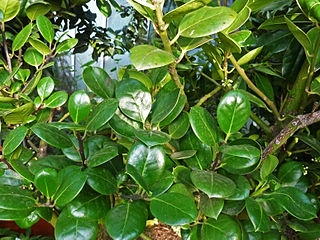
Ilex perado, the Macaronesian holly, is a species of holly endemic to Macaronesia, distributed throughout the Azores, Madeira and Canary islands. It is an important component of the natural high-altitude Macaronesian rainforest, known as 'laurisilva', found mostly at 500 to 1,200 m altitude but it also appears in forest formations at lower elevation. Many of the subspecies have been classified as threatened, probably because of very small population sizes, and are protected by local, national and regional legislation.


















